Related Research Articles

Totnes is a market town and civil parish at the head of the estuary of the River Dart in Devon, England, within the South Devon Area of Outstanding Natural Beauty. It is about 5 miles (8.0 km) west of Paignton, about 7 miles (11 km) west-southwest of Torquay and about 20 miles (32 km) east-northeast of Plymouth. It is the administrative centre of the South Hams District Council.

The rood screen is a common feature in late medieval church architecture. It is typically an ornate partition between the chancel and nave, of more or less open tracery constructed of wood, stone, or wrought iron. The rood screen would originally have been surmounted by a rood loft carrying the Great Rood, a sculptural representation of the Crucifixion. In English, Scottish, and Welsh cathedrals, monastic, and collegiate churches, there were commonly two transverse screens, with a rood screen or rood beam located one bay west of the pulpitum screen, but this double arrangement nowhere survives complete, and accordingly the preserved pulpitum in such churches is sometimes referred to as a rood screen. At Wells Cathedral the medieval arrangement was restored in the 20th century, with the medieval strainer arch supporting a rood, placed in front of the pulpitum and organ.

Barnstaple Castle stood near what is now the centre of the town of Barnstaple, Devon. When it was built, it was on the western side of the fortified town and commanded a good view of both the town and its important river crossings. The castle was built on top of an early medieval cemetery.
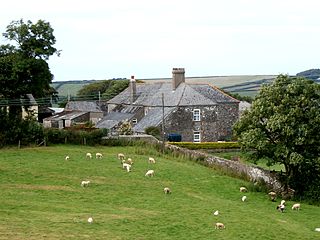
Halsbury is a historic manor in the parish of Parkham in North Devon, England. It is situated 2 miles north-east of the village of Parkham and 4 miles south-west of the town of Bideford. Halsbury was long a seat of the ancient Giffard family, a distant descendant of which was the celebrated lawyer Hardinge Stanley Giffard, 1st Earl of Halsbury (1823–1921), who adopted the name Halsbury for his earldom and was the author of the essential legal reference books Halsbury's Statutes. Halsbury Barton, now a farmhouse, retains 16th- and 17th-century elements of the former manor house of the Giffard family. It was described in a record of 1560 as a "new dwelling house".
Juhel de Totnes, Latinised to Judhellus filius Aluredi, "Juhel son of Alured") was a soldier and supporter of William the Conqueror (1066–1087). He was the first feudal baron of Totnes and feudal baron of Barnstaple, both in Devon.
The Catholic diocese of Rapolla, in Basilicata, existed from the eleventh century until 1528. In that year it was united with the diocese of Melfi, to form the diocese of Melfi e Rapolla. The diocese was suppressed in 1986.

Frithelstock is a village, civil parish and former manor in Devon, England. It is located within Torridge local authority area and formed part of the historic Shebbear hundred. The parish is surrounded, clockwise from the north, by the parishes of Monkleigh, Great Torrington, Little Torrington, Langtree and Buckland Brewer. In 2001 its population was 366, down from 429 in 1901.

Hatfield Broad Oak Priory, or Hatfield Regis Priory, is a former Benedictine priory in Hatfield Broad Oak, Essex, England. Founded by 1139, it was dissolved in 1536 as part of Henry VIII's dissolution of the monasteries.
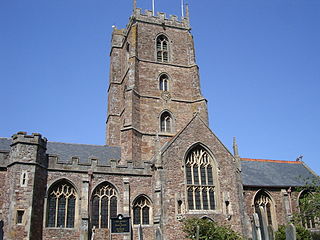
Dunster Priory was established as a Benedictine monastery around 1100 in Dunster, Somerset, England.
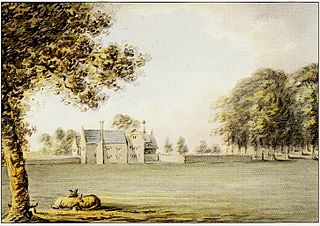
Cowick is a suburb of the City of Exeter in Devon. Historically it was a manor situated in the parish of St Thomas, Exeter, within the hundred of Wonford. It was formerly the site of a Benedictine monastery.

Lammana Priory was a priory on Looe Island in Cornwall, UK, consisting of two Benedictine monks until 1289. It was owned by Glastonbury Abbey and the property was sold in 1289 to a local landowner.

Various monasteries and other religious houses have existed at various times during the Middle Ages in the city of Exeter, Devon, England.
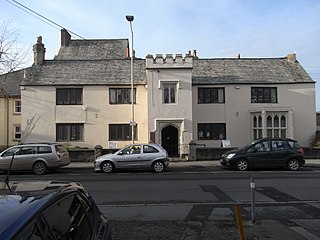
The Priory of St Mary Magdalene in Barnstaple was a priory in Devon, England. It was founded in about 1107 by Juhel de Totnes, feudal baron of Barnstaple, who had earlier founded Totnes Priory in about 1087 at the caput of his former feudal barony of Totnes, from which he had been expelled. Barnstaple Priory was of the Cluniac order. It was dedicated to St Mary Magdalene. It was situated on land outside the town walls stretching from the North Gate to the East Gate with the River Yeo forming its northern boundary. Nearby to the north across the River Yeo was the Benedictine Pilton Priory of St Mary the Virgin, a cell of Malmesbury Abbey, founded slightly later, between 1107 and 1199.

The Church of St Thomas of Canterbury is situated in the village of Kingswear in the English county of Devon, it stands in a slightly elevated position at the junction of Higher Street and Church Hill close to the railway station and the Dartmouth Lower Ferry and overlooks the River Dart. The church is a grade II listed building.

From AD 1066, the feudal barony of Barnstaple was a large feudal barony with its caput at the town of Barnstaple in north Devon, England. It was one of eight feudal baronies in Devonshire which existed in the Middle Ages. In 1236 it comprised 56 knight's fees or individual member manors. The feudal service owed for half the barony in 1274 was the provision to the royal army of two knights or four sergeants for forty days per annum, later commuted to scutage.

Richard Duke was a lawyer and served as Clerk of the Court of Augmentations which position assisted him in acquiring large grants of former monastic lands in the West Country following the Dissolution of the Monasteries. He served as MP for Weymouth in 1545 and for Dartmouth in 1547 and as Sheriff of Devon in 1563–64.

Sir Thomas Denys of Holcombe Burnell, near Exeter, Devon, was a prominent lawyer who served as Sheriff of Devon nine times between 1507/8 to 1553/4 and as MP for Devon. He acquired large estates in Devon at the Dissolution of the Monasteries.
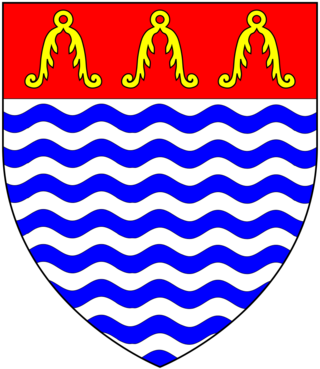
Bernard Smith of Totnes in Devon was MP for Totnes in 1558. He was mayor of Totnes in 1549–50 and c. 1565–6, and was escheator of Devon and Cornwall in 1567–8.

Chivelstone is a village and civil parish in Devon, England. The parish contains the villages of East Prawle and South Allington as well as the hamlets of Ford and Lannacombe. The population of the parish taken at the 2011 census was 280.

Ambrose Bellot, of Downton in Devon was a Member of Parliament for East Looe in Cornwall in 1597.
References
- ↑ "HOLE OF PARKE". Nationalarchives.gov.uk. Retrieved 28 November 2014.
- ↑ Pevsner, Nikolaus & Cherry, Bridget, The Buildings of England: Devon, London, 2004, p.869
- ↑ "Hawkyard, A.D.K., biography of Bernard Smith published in History of Parliament: the House of Commons 1509-1558, ed. S.T. Bindoff, 1982". Historyofparliamentonline.org. Retrieved 28 November 2014.